Hospitality Consumer Behaviour: Factors, Trends, and Decision Making
VerifiedAdded on 2023/01/12
|11
|3331
|77
Report
AI Summary
This report provides a comprehensive analysis of consumer behavior within the hospitality industry. It begins by exploring the cultural, social, personal, and psychological factors that influence consumer attitudes and behaviors, using Travelodge as a case study. The report then examines the impact of digital technology on changing consumer trends and maps the consumer decision-making journey, including a path to purchase for a given hospitality service like hosting a conference. It further compares decision-making processes in B2B and B2C contexts and evaluates various market research approaches and methods. Finally, the report discusses the role of marketers in influencing consumer decisions within the hospitality sector, increasing ROI, integrating customer data and continuous engagement. The report provides valuable insights into understanding consumer behavior to develop effective marketing strategies and enhance customer satisfaction.

Hospitality
Consumer
Consumer
Paraphrase This Document
Need a fresh take? Get an instant paraphrase of this document with our AI Paraphraser
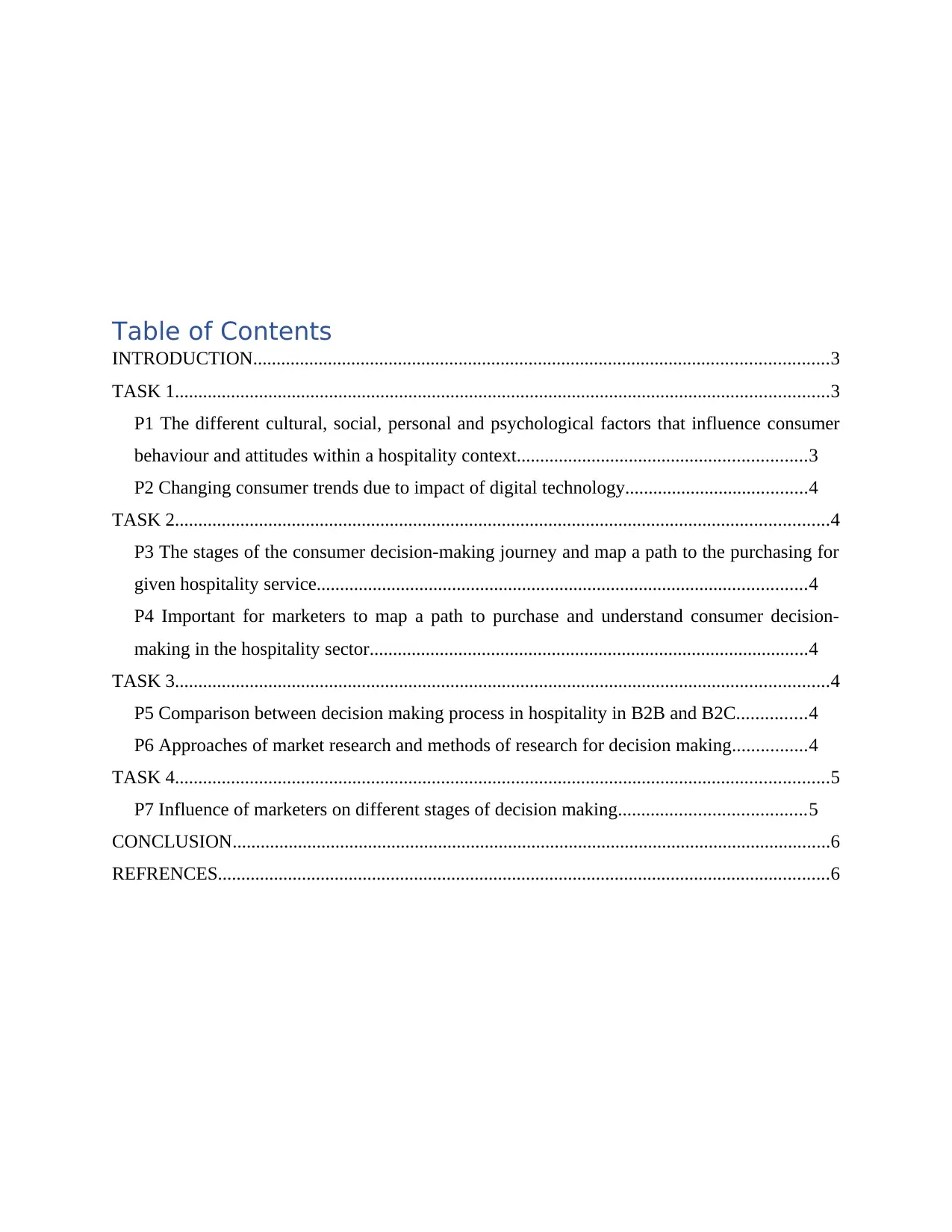
Table of Contents
INTRODUCTION...........................................................................................................................3
TASK 1............................................................................................................................................3
P1 The different cultural, social, personal and psychological factors that influence consumer
behaviour and attitudes within a hospitality context..............................................................3
P2 Changing consumer trends due to impact of digital technology.......................................4
TASK 2............................................................................................................................................4
P3 The stages of the consumer decision-making journey and map a path to the purchasing for
given hospitality service.........................................................................................................4
P4 Important for marketers to map a path to purchase and understand consumer decision-
making in the hospitality sector..............................................................................................4
TASK 3............................................................................................................................................4
P5 Comparison between decision making process in hospitality in B2B and B2C...............4
P6 Approaches of market research and methods of research for decision making................4
TASK 4............................................................................................................................................5
P7 Influence of marketers on different stages of decision making........................................5
CONCLUSION................................................................................................................................6
REFRENCES...................................................................................................................................6
INTRODUCTION...........................................................................................................................3
TASK 1............................................................................................................................................3
P1 The different cultural, social, personal and psychological factors that influence consumer
behaviour and attitudes within a hospitality context..............................................................3
P2 Changing consumer trends due to impact of digital technology.......................................4
TASK 2............................................................................................................................................4
P3 The stages of the consumer decision-making journey and map a path to the purchasing for
given hospitality service.........................................................................................................4
P4 Important for marketers to map a path to purchase and understand consumer decision-
making in the hospitality sector..............................................................................................4
TASK 3............................................................................................................................................4
P5 Comparison between decision making process in hospitality in B2B and B2C...............4
P6 Approaches of market research and methods of research for decision making................4
TASK 4............................................................................................................................................5
P7 Influence of marketers on different stages of decision making........................................5
CONCLUSION................................................................................................................................6
REFRENCES...................................................................................................................................6

INTRODUCTION
Consumer behaviour can be said to be a study which shows the pattern, attitude and all the
factors which a consumer considers while buying a product or a service. It is always based upon
actuals of a consumer which takes place within a market place in order to form proper strategies
by any organisation. In this report Travelodge has been chosen which was founded in year 1939.
It’s headquarter is situated in California, United States (Ashman, Solomon and Wolny, 2015). In
this assignment discussion about different cultural, social factors which are influencing consumer
behaviour, stage of consumer decision-making, changing consumer trends, important mapping
part, comparison of B2B and B2C, evaluation of different approaches of market research
followed by rule of marketers in influencing hospitality industry in decision making process is
included.
TASK 1
P1 The different cultural, social, personal and psychological factors that influence consumer
behaviour and attitudes within a hospitality context
Customer satisfaction can be defined as the level of awareness and acceptance of service
for costume. This is an emotional response of a customer towards expectation from a product,
performance or quality of the product. Various factors which influence consumer behaviour and
attitude or cultural factors, social factors and personal factors.
Cultural factors: Cultural factors contain importance in estimating consumer behaviour and
attitude towards a product or a service. This is a basic field that influences needs as well as wants
of an individual. The cultural factors influence value, behaviour, perception as well as liking of
a human. Every culture also consist of small sub cultures which provide the methods of
socializing and different identification.
Social factors: Social factors includes family, groups, social rules as well as status which impact
behaviour and attitude of a customer. Through this classification reference group faces influence
on the attitude and behaviour of a consumer. Different important parts of this reference groups
are family, neighbors, friends as well as co-workers. Family is an indispensable part when taking
into account consumer buying behaviour (Banerjee, 2017). It is majorly depending on family
orientation which includes parents, siblings as well as family with spouse and children.
Consumer behaviour can be said to be a study which shows the pattern, attitude and all the
factors which a consumer considers while buying a product or a service. It is always based upon
actuals of a consumer which takes place within a market place in order to form proper strategies
by any organisation. In this report Travelodge has been chosen which was founded in year 1939.
It’s headquarter is situated in California, United States (Ashman, Solomon and Wolny, 2015). In
this assignment discussion about different cultural, social factors which are influencing consumer
behaviour, stage of consumer decision-making, changing consumer trends, important mapping
part, comparison of B2B and B2C, evaluation of different approaches of market research
followed by rule of marketers in influencing hospitality industry in decision making process is
included.
TASK 1
P1 The different cultural, social, personal and psychological factors that influence consumer
behaviour and attitudes within a hospitality context
Customer satisfaction can be defined as the level of awareness and acceptance of service
for costume. This is an emotional response of a customer towards expectation from a product,
performance or quality of the product. Various factors which influence consumer behaviour and
attitude or cultural factors, social factors and personal factors.
Cultural factors: Cultural factors contain importance in estimating consumer behaviour and
attitude towards a product or a service. This is a basic field that influences needs as well as wants
of an individual. The cultural factors influence value, behaviour, perception as well as liking of
a human. Every culture also consist of small sub cultures which provide the methods of
socializing and different identification.
Social factors: Social factors includes family, groups, social rules as well as status which impact
behaviour and attitude of a customer. Through this classification reference group faces influence
on the attitude and behaviour of a consumer. Different important parts of this reference groups
are family, neighbors, friends as well as co-workers. Family is an indispensable part when taking
into account consumer buying behaviour (Banerjee, 2017). It is majorly depending on family
orientation which includes parents, siblings as well as family with spouse and children.
⊘ This is a preview!⊘
Do you want full access?
Subscribe today to unlock all pages.

Trusted by 1+ million students worldwide

Personal factors: This includes ages as Willis stages in the life cycle. It also takes into account
occupational as well as economic conditions of an individual including their personality and self-
development values and lifestyle. Customers usually evaluate price, size, of a product and
service offered by any organisation. Places a customer needs to visit while buying a product is
also important.
P2 Changing consumer trends due to impact of digital technology
Internet is one of the important tools when influencing customers. It has had a great impact
on consumer attitude and buying behaviour. Generally, a number of hotels use cyber marketing
to promote their services. In this way they also provide a number of discounts and offers to their
customers. In context of travel lodge, a number of bookings are taken online from different
websites such as make my trip, trip advisor and so on.
Consumers can also provide feedback and upload many pictures from their trips at given
hospitality sector company. This helps consumer to decide on which service to choose. There are
also various options where people mention their experiences at hotel (Frederiks, Stenner and
Hobman, 2015). Travelodge takes extra initiative to make sure that all its customer fills the
feedback form. Also, in case there is any negative feedback they try and work on it.
TASK 2
P3 The stages of the consumer decision-making journey and map a path to the purchasing for
given hospitality service
Consumer decision-making can be explained as actual news consumers in at most
appropriate product or services amongst various alternatives available to them. This involves all
the steps which starts from identification of needs, extraction of relevant information,
examinations as well as evaluation of all the available alternatives and at the end it is closed by
making a purchase decision.
Number of factors such as social, psychological, emotional and so on which affect the
choices all divine decision of customer. Consumer decision-making faces is contributing
organisation to deter mine the buying behaviour of customer and also take various types increase
awareness about their products and services Ltd. The set of procedures which comprises of
different stages of customer buying behaviour through customer decision making are mentioned
below:
occupational as well as economic conditions of an individual including their personality and self-
development values and lifestyle. Customers usually evaluate price, size, of a product and
service offered by any organisation. Places a customer needs to visit while buying a product is
also important.
P2 Changing consumer trends due to impact of digital technology
Internet is one of the important tools when influencing customers. It has had a great impact
on consumer attitude and buying behaviour. Generally, a number of hotels use cyber marketing
to promote their services. In this way they also provide a number of discounts and offers to their
customers. In context of travel lodge, a number of bookings are taken online from different
websites such as make my trip, trip advisor and so on.
Consumers can also provide feedback and upload many pictures from their trips at given
hospitality sector company. This helps consumer to decide on which service to choose. There are
also various options where people mention their experiences at hotel (Frederiks, Stenner and
Hobman, 2015). Travelodge takes extra initiative to make sure that all its customer fills the
feedback form. Also, in case there is any negative feedback they try and work on it.
TASK 2
P3 The stages of the consumer decision-making journey and map a path to the purchasing for
given hospitality service
Consumer decision-making can be explained as actual news consumers in at most
appropriate product or services amongst various alternatives available to them. This involves all
the steps which starts from identification of needs, extraction of relevant information,
examinations as well as evaluation of all the available alternatives and at the end it is closed by
making a purchase decision.
Number of factors such as social, psychological, emotional and so on which affect the
choices all divine decision of customer. Consumer decision-making faces is contributing
organisation to deter mine the buying behaviour of customer and also take various types increase
awareness about their products and services Ltd. The set of procedures which comprises of
different stages of customer buying behaviour through customer decision making are mentioned
below:
Paraphrase This Document
Need a fresh take? Get an instant paraphrase of this document with our AI Paraphraser
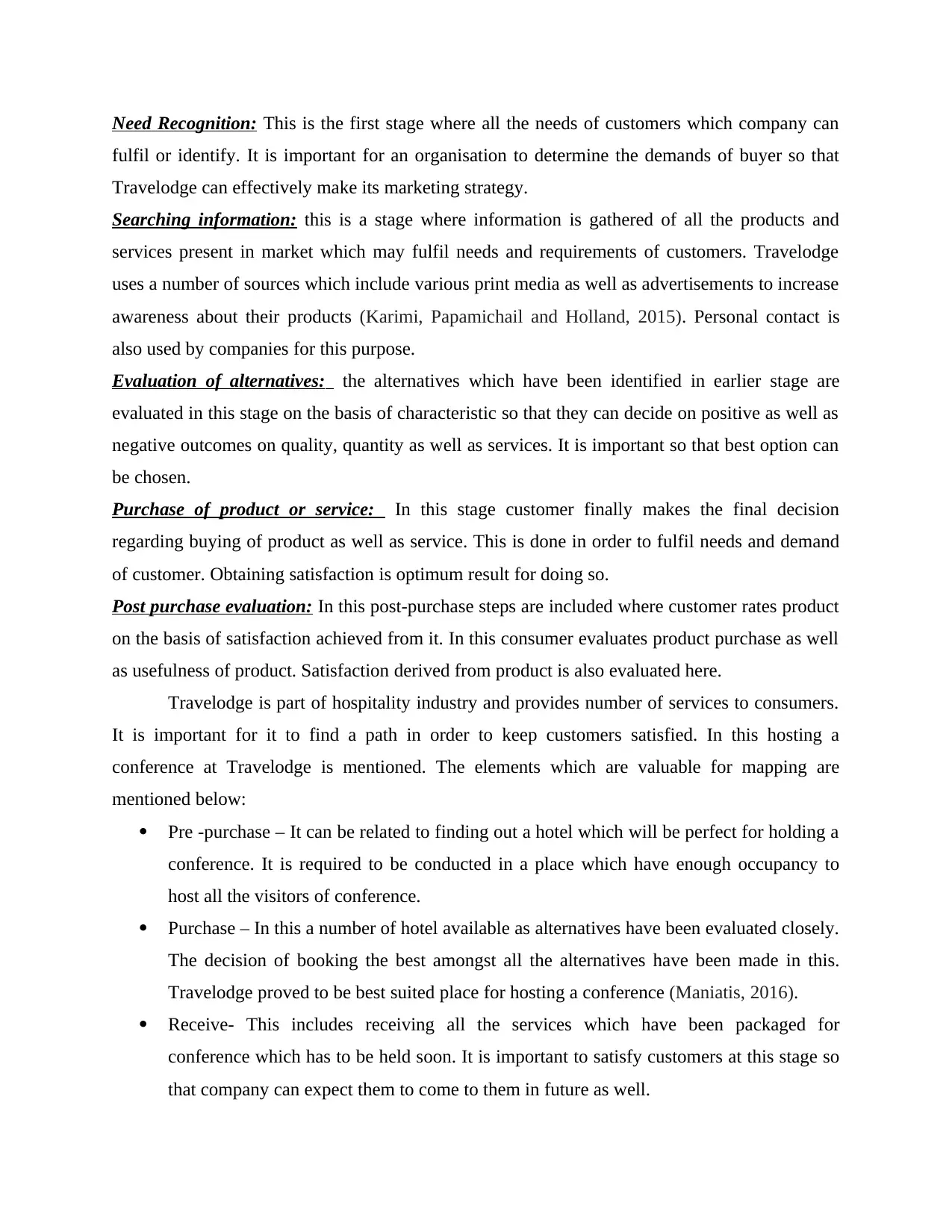
Need Recognition: This is the first stage where all the needs of customers which company can
fulfil or identify. It is important for an organisation to determine the demands of buyer so that
Travelodge can effectively make its marketing strategy.
Searching information: this is a stage where information is gathered of all the products and
services present in market which may fulfil needs and requirements of customers. Travelodge
uses a number of sources which include various print media as well as advertisements to increase
awareness about their products (Karimi, Papamichail and Holland, 2015). Personal contact is
also used by companies for this purpose.
Evaluation of alternatives: the alternatives which have been identified in earlier stage are
evaluated in this stage on the basis of characteristic so that they can decide on positive as well as
negative outcomes on quality, quantity as well as services. It is important so that best option can
be chosen.
Purchase of product or service: In this stage customer finally makes the final decision
regarding buying of product as well as service. This is done in order to fulfil needs and demand
of customer. Obtaining satisfaction is optimum result for doing so.
Post purchase evaluation: In this post-purchase steps are included where customer rates product
on the basis of satisfaction achieved from it. In this consumer evaluates product purchase as well
as usefulness of product. Satisfaction derived from product is also evaluated here.
Travelodge is part of hospitality industry and provides number of services to consumers.
It is important for it to find a path in order to keep customers satisfied. In this hosting a
conference at Travelodge is mentioned. The elements which are valuable for mapping are
mentioned below:
Pre -purchase – It can be related to finding out a hotel which will be perfect for holding a
conference. It is required to be conducted in a place which have enough occupancy to
host all the visitors of conference.
Purchase – In this a number of hotel available as alternatives have been evaluated closely.
The decision of booking the best amongst all the alternatives have been made in this.
Travelodge proved to be best suited place for hosting a conference (Maniatis, 2016).
Receive- This includes receiving all the services which have been packaged for
conference which has to be held soon. It is important to satisfy customers at this stage so
that company can expect them to come to them in future as well.
fulfil or identify. It is important for an organisation to determine the demands of buyer so that
Travelodge can effectively make its marketing strategy.
Searching information: this is a stage where information is gathered of all the products and
services present in market which may fulfil needs and requirements of customers. Travelodge
uses a number of sources which include various print media as well as advertisements to increase
awareness about their products (Karimi, Papamichail and Holland, 2015). Personal contact is
also used by companies for this purpose.
Evaluation of alternatives: the alternatives which have been identified in earlier stage are
evaluated in this stage on the basis of characteristic so that they can decide on positive as well as
negative outcomes on quality, quantity as well as services. It is important so that best option can
be chosen.
Purchase of product or service: In this stage customer finally makes the final decision
regarding buying of product as well as service. This is done in order to fulfil needs and demand
of customer. Obtaining satisfaction is optimum result for doing so.
Post purchase evaluation: In this post-purchase steps are included where customer rates product
on the basis of satisfaction achieved from it. In this consumer evaluates product purchase as well
as usefulness of product. Satisfaction derived from product is also evaluated here.
Travelodge is part of hospitality industry and provides number of services to consumers.
It is important for it to find a path in order to keep customers satisfied. In this hosting a
conference at Travelodge is mentioned. The elements which are valuable for mapping are
mentioned below:
Pre -purchase – It can be related to finding out a hotel which will be perfect for holding a
conference. It is required to be conducted in a place which have enough occupancy to
host all the visitors of conference.
Purchase – In this a number of hotel available as alternatives have been evaluated closely.
The decision of booking the best amongst all the alternatives have been made in this.
Travelodge proved to be best suited place for hosting a conference (Maniatis, 2016).
Receive- This includes receiving all the services which have been packaged for
conference which has to be held soon. It is important to satisfy customers at this stage so
that company can expect them to come to them in future as well.

Post-purchase- At this stage customers focus on evaluating the satisfaction they have
received from the services provided by Travelodge. It helps a customer to decide whether
want to hire these services in future or not. This is why Travelodge is required to provide
services to satisfy customers with excellent quality services.
P4 Important for marketers to map a path to purchase and understand consumer decision-making
in the hospitality sector
There are a number of motives for establishment of an organisation and providing
customer satisfaction is one of the major motives. Customer satisfaction can be easily achieved
by understanding the decision-making title of the consumer and all the factors which affect
Consumers decision making. Therefore, it is important for an organisation to map the purchase
of the same. The mapping part of purchase of marketers is as follows:
Increases ROI- there are a number of aspects take me to consideration with an intention of
changing the consumer is buying behaviour while purchase of a product or service (Wang and
Yu, 2017). There are a number of ways which marketers follow in order to reach a large number
of customers. In context of Travelodge, company have higher return on investment through
providing customization of services for their customers.
Integrated customer data and continuous engagement- Travelodge make sure that they have
all the required data and services maintained of the customers which is divided into particular
groups as the target their customers. Categorising various customers according to their buying
behaviour helps company in taking special efforts in order to satisfy their consumers.
Along with this mapping is also necessary in order to divide the activities as well as efforts of a
consumer at different levels of decision-making related to any good or service. These levels
include:
Extensive problem-solving- This is required when the goods and services which are purchased
by a consumer are not identical or familiar with the consumers. This usually takes more than
expected time for a consumer to make decision.
Limited problem-solving- At this stage consumer has good information and knowledge about the
product and services along with all the alternatives available for those products or services in
market. It generally includes a comparison between substitutes of products and services. Time
required here is only taken by a consumer for choosing between various substitutes.
received from the services provided by Travelodge. It helps a customer to decide whether
want to hire these services in future or not. This is why Travelodge is required to provide
services to satisfy customers with excellent quality services.
P4 Important for marketers to map a path to purchase and understand consumer decision-making
in the hospitality sector
There are a number of motives for establishment of an organisation and providing
customer satisfaction is one of the major motives. Customer satisfaction can be easily achieved
by understanding the decision-making title of the consumer and all the factors which affect
Consumers decision making. Therefore, it is important for an organisation to map the purchase
of the same. The mapping part of purchase of marketers is as follows:
Increases ROI- there are a number of aspects take me to consideration with an intention of
changing the consumer is buying behaviour while purchase of a product or service (Wang and
Yu, 2017). There are a number of ways which marketers follow in order to reach a large number
of customers. In context of Travelodge, company have higher return on investment through
providing customization of services for their customers.
Integrated customer data and continuous engagement- Travelodge make sure that they have
all the required data and services maintained of the customers which is divided into particular
groups as the target their customers. Categorising various customers according to their buying
behaviour helps company in taking special efforts in order to satisfy their consumers.
Along with this mapping is also necessary in order to divide the activities as well as efforts of a
consumer at different levels of decision-making related to any good or service. These levels
include:
Extensive problem-solving- This is required when the goods and services which are purchased
by a consumer are not identical or familiar with the consumers. This usually takes more than
expected time for a consumer to make decision.
Limited problem-solving- At this stage consumer has good information and knowledge about the
product and services along with all the alternatives available for those products or services in
market. It generally includes a comparison between substitutes of products and services. Time
required here is only taken by a consumer for choosing between various substitutes.
⊘ This is a preview!⊘
Do you want full access?
Subscribe today to unlock all pages.

Trusted by 1+ million students worldwide
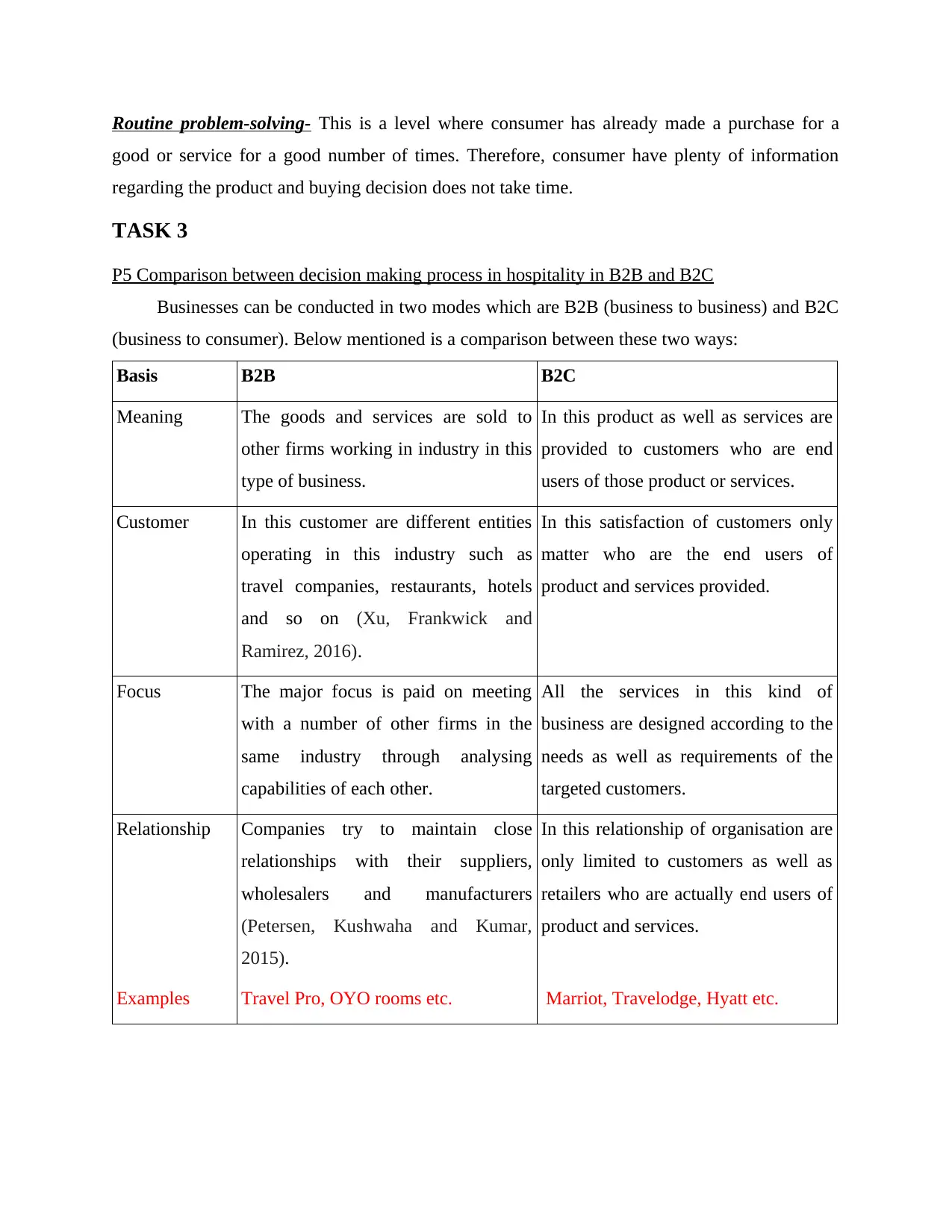
Routine problem-solving- This is a level where consumer has already made a purchase for a
good or service for a good number of times. Therefore, consumer have plenty of information
regarding the product and buying decision does not take time.
TASK 3
P5 Comparison between decision making process in hospitality in B2B and B2C
Businesses can be conducted in two modes which are B2B (business to business) and B2C
(business to consumer). Below mentioned is a comparison between these two ways:
Basis B2B B2C
Meaning The goods and services are sold to
other firms working in industry in this
type of business.
In this product as well as services are
provided to customers who are end
users of those product or services.
Customer In this customer are different entities
operating in this industry such as
travel companies, restaurants, hotels
and so on (Xu, Frankwick and
Ramirez, 2016).
In this satisfaction of customers only
matter who are the end users of
product and services provided.
Focus The major focus is paid on meeting
with a number of other firms in the
same industry through analysing
capabilities of each other.
All the services in this kind of
business are designed according to the
needs as well as requirements of the
targeted customers.
Relationship Companies try to maintain close
relationships with their suppliers,
wholesalers and manufacturers
(Petersen, Kushwaha and Kumar,
2015).
In this relationship of organisation are
only limited to customers as well as
retailers who are actually end users of
product and services.
Examples Travel Pro, OYO rooms etc. Marriot, Travelodge, Hyatt etc.
good or service for a good number of times. Therefore, consumer have plenty of information
regarding the product and buying decision does not take time.
TASK 3
P5 Comparison between decision making process in hospitality in B2B and B2C
Businesses can be conducted in two modes which are B2B (business to business) and B2C
(business to consumer). Below mentioned is a comparison between these two ways:
Basis B2B B2C
Meaning The goods and services are sold to
other firms working in industry in this
type of business.
In this product as well as services are
provided to customers who are end
users of those product or services.
Customer In this customer are different entities
operating in this industry such as
travel companies, restaurants, hotels
and so on (Xu, Frankwick and
Ramirez, 2016).
In this satisfaction of customers only
matter who are the end users of
product and services provided.
Focus The major focus is paid on meeting
with a number of other firms in the
same industry through analysing
capabilities of each other.
All the services in this kind of
business are designed according to the
needs as well as requirements of the
targeted customers.
Relationship Companies try to maintain close
relationships with their suppliers,
wholesalers and manufacturers
(Petersen, Kushwaha and Kumar,
2015).
In this relationship of organisation are
only limited to customers as well as
retailers who are actually end users of
product and services.
Examples Travel Pro, OYO rooms etc. Marriot, Travelodge, Hyatt etc.
Paraphrase This Document
Need a fresh take? Get an instant paraphrase of this document with our AI Paraphraser
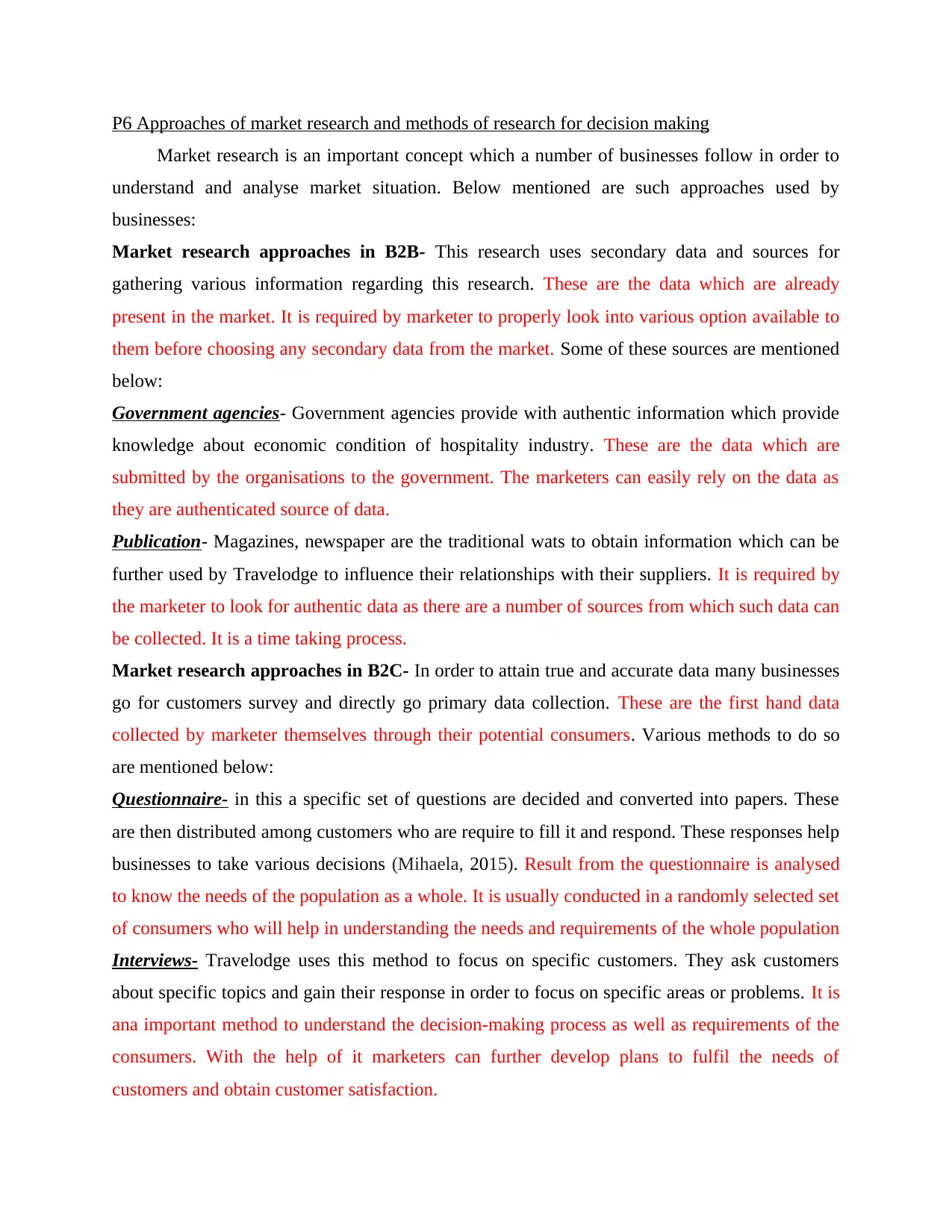
P6 Approaches of market research and methods of research for decision making
Market research is an important concept which a number of businesses follow in order to
understand and analyse market situation. Below mentioned are such approaches used by
businesses:
Market research approaches in B2B- This research uses secondary data and sources for
gathering various information regarding this research. These are the data which are already
present in the market. It is required by marketer to properly look into various option available to
them before choosing any secondary data from the market. Some of these sources are mentioned
below:
Government agencies- Government agencies provide with authentic information which provide
knowledge about economic condition of hospitality industry. These are the data which are
submitted by the organisations to the government. The marketers can easily rely on the data as
they are authenticated source of data.
Publication- Magazines, newspaper are the traditional wats to obtain information which can be
further used by Travelodge to influence their relationships with their suppliers. It is required by
the marketer to look for authentic data as there are a number of sources from which such data can
be collected. It is a time taking process.
Market research approaches in B2C- In order to attain true and accurate data many businesses
go for customers survey and directly go primary data collection. These are the first hand data
collected by marketer themselves through their potential consumers. Various methods to do so
are mentioned below:
Questionnaire- in this a specific set of questions are decided and converted into papers. These
are then distributed among customers who are require to fill it and respond. These responses help
businesses to take various decisions (Mihaela, 2015). Result from the questionnaire is analysed
to know the needs of the population as a whole. It is usually conducted in a randomly selected set
of consumers who will help in understanding the needs and requirements of the whole population
Interviews- Travelodge uses this method to focus on specific customers. They ask customers
about specific topics and gain their response in order to focus on specific areas or problems. It is
ana important method to understand the decision-making process as well as requirements of the
consumers. With the help of it marketers can further develop plans to fulfil the needs of
customers and obtain customer satisfaction.
Market research is an important concept which a number of businesses follow in order to
understand and analyse market situation. Below mentioned are such approaches used by
businesses:
Market research approaches in B2B- This research uses secondary data and sources for
gathering various information regarding this research. These are the data which are already
present in the market. It is required by marketer to properly look into various option available to
them before choosing any secondary data from the market. Some of these sources are mentioned
below:
Government agencies- Government agencies provide with authentic information which provide
knowledge about economic condition of hospitality industry. These are the data which are
submitted by the organisations to the government. The marketers can easily rely on the data as
they are authenticated source of data.
Publication- Magazines, newspaper are the traditional wats to obtain information which can be
further used by Travelodge to influence their relationships with their suppliers. It is required by
the marketer to look for authentic data as there are a number of sources from which such data can
be collected. It is a time taking process.
Market research approaches in B2C- In order to attain true and accurate data many businesses
go for customers survey and directly go primary data collection. These are the first hand data
collected by marketer themselves through their potential consumers. Various methods to do so
are mentioned below:
Questionnaire- in this a specific set of questions are decided and converted into papers. These
are then distributed among customers who are require to fill it and respond. These responses help
businesses to take various decisions (Mihaela, 2015). Result from the questionnaire is analysed
to know the needs of the population as a whole. It is usually conducted in a randomly selected set
of consumers who will help in understanding the needs and requirements of the whole population
Interviews- Travelodge uses this method to focus on specific customers. They ask customers
about specific topics and gain their response in order to focus on specific areas or problems. It is
ana important method to understand the decision-making process as well as requirements of the
consumers. With the help of it marketers can further develop plans to fulfil the needs of
customers and obtain customer satisfaction.
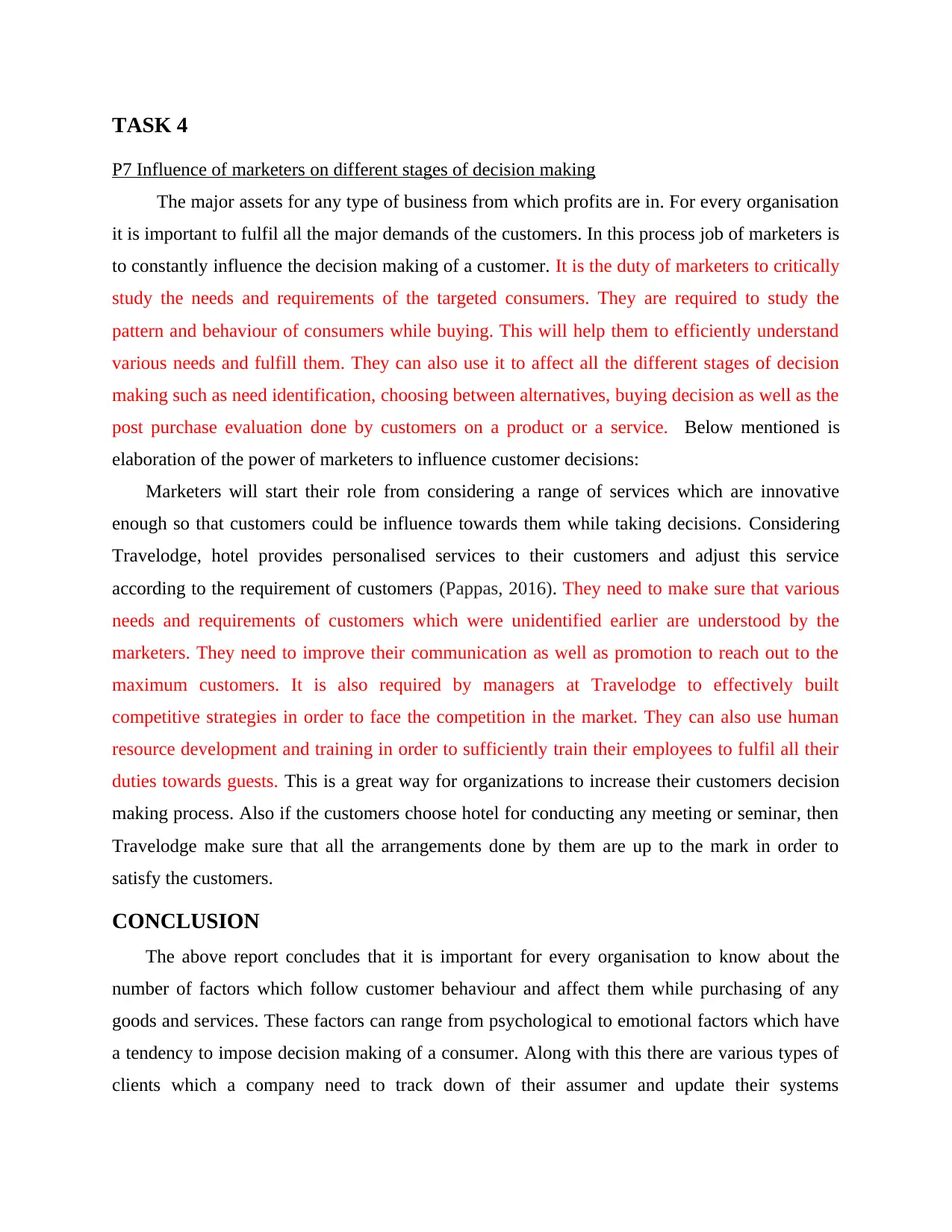
TASK 4
P7 Influence of marketers on different stages of decision making
The major assets for any type of business from which profits are in. For every organisation
it is important to fulfil all the major demands of the customers. In this process job of marketers is
to constantly influence the decision making of a customer. It is the duty of marketers to critically
study the needs and requirements of the targeted consumers. They are required to study the
pattern and behaviour of consumers while buying. This will help them to efficiently understand
various needs and fulfill them. They can also use it to affect all the different stages of decision
making such as need identification, choosing between alternatives, buying decision as well as the
post purchase evaluation done by customers on a product or a service. Below mentioned is
elaboration of the power of marketers to influence customer decisions:
Marketers will start their role from considering a range of services which are innovative
enough so that customers could be influence towards them while taking decisions. Considering
Travelodge, hotel provides personalised services to their customers and adjust this service
according to the requirement of customers (Pappas, 2016). They need to make sure that various
needs and requirements of customers which were unidentified earlier are understood by the
marketers. They need to improve their communication as well as promotion to reach out to the
maximum customers. It is also required by managers at Travelodge to effectively built
competitive strategies in order to face the competition in the market. They can also use human
resource development and training in order to sufficiently train their employees to fulfil all their
duties towards guests. This is a great way for organizations to increase their customers decision
making process. Also if the customers choose hotel for conducting any meeting or seminar, then
Travelodge make sure that all the arrangements done by them are up to the mark in order to
satisfy the customers.
CONCLUSION
The above report concludes that it is important for every organisation to know about the
number of factors which follow customer behaviour and affect them while purchasing of any
goods and services. These factors can range from psychological to emotional factors which have
a tendency to impose decision making of a consumer. Along with this there are various types of
clients which a company need to track down of their assumer and update their systems
P7 Influence of marketers on different stages of decision making
The major assets for any type of business from which profits are in. For every organisation
it is important to fulfil all the major demands of the customers. In this process job of marketers is
to constantly influence the decision making of a customer. It is the duty of marketers to critically
study the needs and requirements of the targeted consumers. They are required to study the
pattern and behaviour of consumers while buying. This will help them to efficiently understand
various needs and fulfill them. They can also use it to affect all the different stages of decision
making such as need identification, choosing between alternatives, buying decision as well as the
post purchase evaluation done by customers on a product or a service. Below mentioned is
elaboration of the power of marketers to influence customer decisions:
Marketers will start their role from considering a range of services which are innovative
enough so that customers could be influence towards them while taking decisions. Considering
Travelodge, hotel provides personalised services to their customers and adjust this service
according to the requirement of customers (Pappas, 2016). They need to make sure that various
needs and requirements of customers which were unidentified earlier are understood by the
marketers. They need to improve their communication as well as promotion to reach out to the
maximum customers. It is also required by managers at Travelodge to effectively built
competitive strategies in order to face the competition in the market. They can also use human
resource development and training in order to sufficiently train their employees to fulfil all their
duties towards guests. This is a great way for organizations to increase their customers decision
making process. Also if the customers choose hotel for conducting any meeting or seminar, then
Travelodge make sure that all the arrangements done by them are up to the mark in order to
satisfy the customers.
CONCLUSION
The above report concludes that it is important for every organisation to know about the
number of factors which follow customer behaviour and affect them while purchasing of any
goods and services. These factors can range from psychological to emotional factors which have
a tendency to impose decision making of a consumer. Along with this there are various types of
clients which a company need to track down of their assumer and update their systems
⊘ This is a preview!⊘
Do you want full access?
Subscribe today to unlock all pages.

Trusted by 1+ million students worldwide
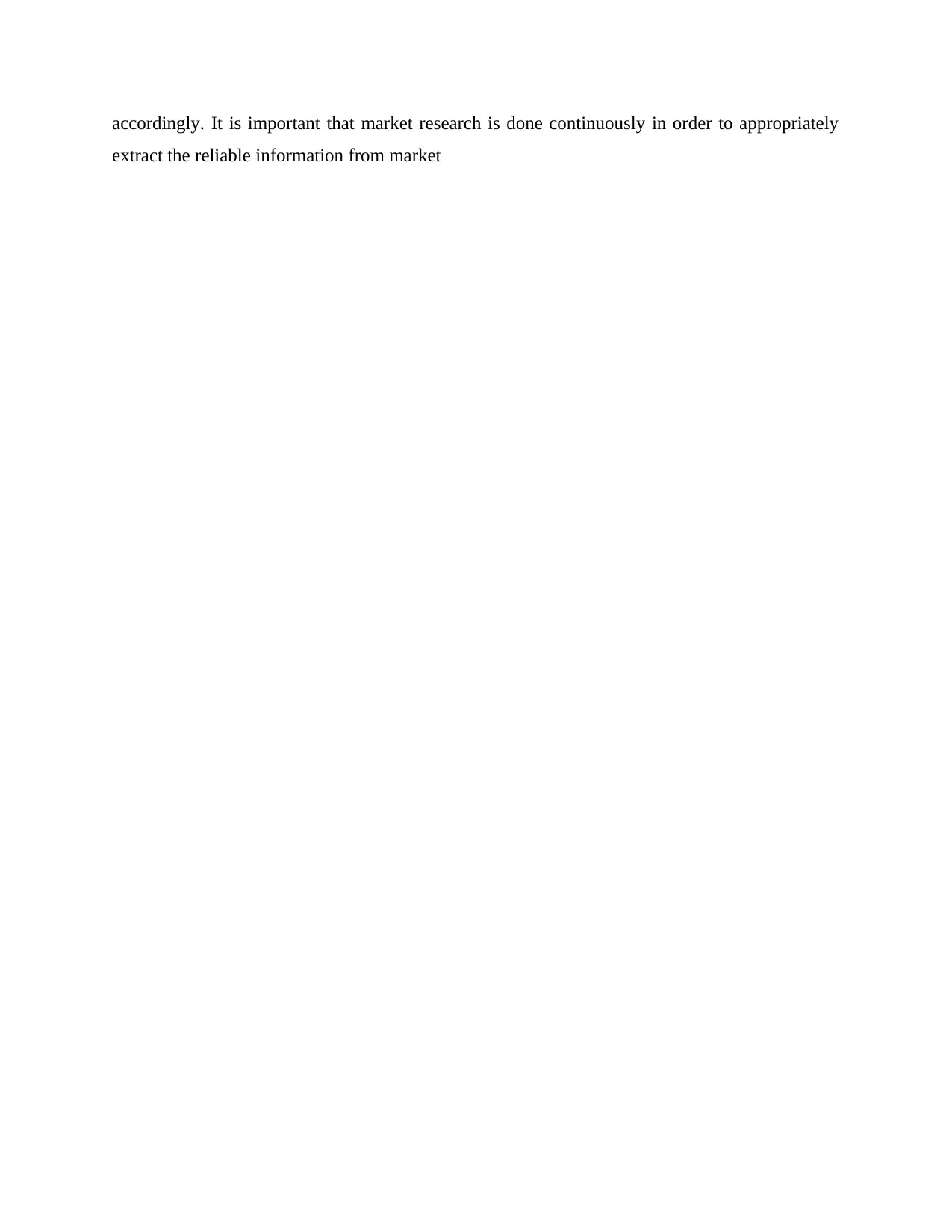
accordingly. It is important that market research is done continuously in order to appropriately
extract the reliable information from market
extract the reliable information from market
Paraphrase This Document
Need a fresh take? Get an instant paraphrase of this document with our AI Paraphraser
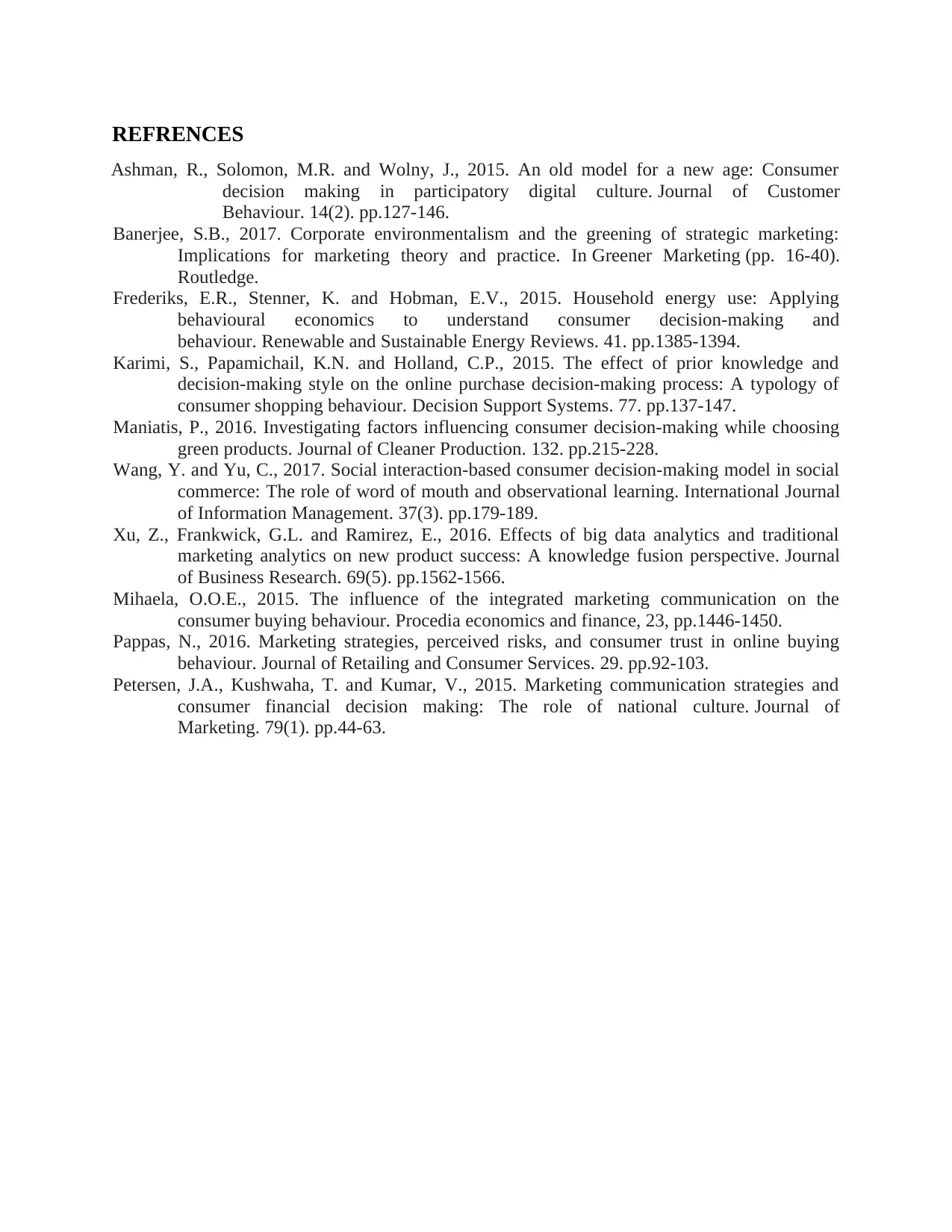
REFRENCES
Ashman, R., Solomon, M.R. and Wolny, J., 2015. An old model for a new age: Consumer
decision making in participatory digital culture. Journal of Customer
Behaviour. 14(2). pp.127-146.
Banerjee, S.B., 2017. Corporate environmentalism and the greening of strategic marketing:
Implications for marketing theory and practice. In Greener Marketing (pp. 16-40).
Routledge.
Frederiks, E.R., Stenner, K. and Hobman, E.V., 2015. Household energy use: Applying
behavioural economics to understand consumer decision-making and
behaviour. Renewable and Sustainable Energy Reviews. 41. pp.1385-1394.
Karimi, S., Papamichail, K.N. and Holland, C.P., 2015. The effect of prior knowledge and
decision-making style on the online purchase decision-making process: A typology of
consumer shopping behaviour. Decision Support Systems. 77. pp.137-147.
Maniatis, P., 2016. Investigating factors influencing consumer decision-making while choosing
green products. Journal of Cleaner Production. 132. pp.215-228.
Wang, Y. and Yu, C., 2017. Social interaction-based consumer decision-making model in social
commerce: The role of word of mouth and observational learning. International Journal
of Information Management. 37(3). pp.179-189.
Xu, Z., Frankwick, G.L. and Ramirez, E., 2016. Effects of big data analytics and traditional
marketing analytics on new product success: A knowledge fusion perspective. Journal
of Business Research. 69(5). pp.1562-1566.
Mihaela, O.O.E., 2015. The influence of the integrated marketing communication on the
consumer buying behaviour. Procedia economics and finance, 23, pp.1446-1450.
Pappas, N., 2016. Marketing strategies, perceived risks, and consumer trust in online buying
behaviour. Journal of Retailing and Consumer Services. 29. pp.92-103.
Petersen, J.A., Kushwaha, T. and Kumar, V., 2015. Marketing communication strategies and
consumer financial decision making: The role of national culture. Journal of
Marketing. 79(1). pp.44-63.
Ashman, R., Solomon, M.R. and Wolny, J., 2015. An old model for a new age: Consumer
decision making in participatory digital culture. Journal of Customer
Behaviour. 14(2). pp.127-146.
Banerjee, S.B., 2017. Corporate environmentalism and the greening of strategic marketing:
Implications for marketing theory and practice. In Greener Marketing (pp. 16-40).
Routledge.
Frederiks, E.R., Stenner, K. and Hobman, E.V., 2015. Household energy use: Applying
behavioural economics to understand consumer decision-making and
behaviour. Renewable and Sustainable Energy Reviews. 41. pp.1385-1394.
Karimi, S., Papamichail, K.N. and Holland, C.P., 2015. The effect of prior knowledge and
decision-making style on the online purchase decision-making process: A typology of
consumer shopping behaviour. Decision Support Systems. 77. pp.137-147.
Maniatis, P., 2016. Investigating factors influencing consumer decision-making while choosing
green products. Journal of Cleaner Production. 132. pp.215-228.
Wang, Y. and Yu, C., 2017. Social interaction-based consumer decision-making model in social
commerce: The role of word of mouth and observational learning. International Journal
of Information Management. 37(3). pp.179-189.
Xu, Z., Frankwick, G.L. and Ramirez, E., 2016. Effects of big data analytics and traditional
marketing analytics on new product success: A knowledge fusion perspective. Journal
of Business Research. 69(5). pp.1562-1566.
Mihaela, O.O.E., 2015. The influence of the integrated marketing communication on the
consumer buying behaviour. Procedia economics and finance, 23, pp.1446-1450.
Pappas, N., 2016. Marketing strategies, perceived risks, and consumer trust in online buying
behaviour. Journal of Retailing and Consumer Services. 29. pp.92-103.
Petersen, J.A., Kushwaha, T. and Kumar, V., 2015. Marketing communication strategies and
consumer financial decision making: The role of national culture. Journal of
Marketing. 79(1). pp.44-63.
1 out of 11
Related Documents
Your All-in-One AI-Powered Toolkit for Academic Success.
+13062052269
info@desklib.com
Available 24*7 on WhatsApp / Email
![[object Object]](/_next/static/media/star-bottom.7253800d.svg)
Unlock your academic potential
Copyright © 2020–2025 A2Z Services. All Rights Reserved. Developed and managed by ZUCOL.




